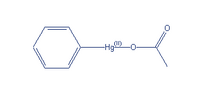It:Phenylmercury Acetate
| It:Phenylmercury Acetate | ||
|---|---|---|

| ||
| General | ||
| Systematic name | Phenylmercury Acetate | |
| Molecular formula | C8H8HgO2 | |
| SMILES | InChI=1/C6H5.C2H4O2.Hg/c1-2-4-6-5-3-1;1-2(3)4;/h1-5H;1H3,(H,3,4);/q;;+1/p-1/fC6H5.C2H3O2.Hg/q;-1;m/rC8H8HgO2/c1-7(10)11-9-8-5-3-2-4-6-8/h2-6H,1H3 | |
| Molar mass | 336.74g/mol | |
| CAS number | 62-38-4 | |
| Properties | ||
| Melting point | 149°C | |
| Main hazards | toxic if inhaled, swallowed or absorbed through skin corrosive | |
| R/S statement | R24 R25 R34 R48 R50 R53: S23 S24 S25 S37 S45 S60 S61. : |
|
Headline text
Introduction
Phenylmercury acetate is an organomercury compound. It was widely used as antisepic untill mercury poisoning became clear and nowadays it is hardly used in medical field. Mercury compound has been used frequently as an antiseptic for many years before this compound was introduced. A very common chemical used as an antiseptic before phenylmercury acetate was mercury chloride. This is because the Mercury +2 ion dissociated from the compound is particularly good as an antiseptic. After series of researches, it became clear organomurcury was a much better than inorganic compound of murcury, so synthesis of good organomercury compound was a very good inductrial process.
Reaction
Phenyl mercury acetate reacts with R-SH first removing the acetate functional group called the phenylmercury thiolate, then additional R-SH is added to remove mercury from the compound leaving the benzene ring. Mercury dithiolate, RS-Hg-SR further decomposes to Hg +2 ion and 2RSH. Final products are benzene ring ,mercury ion.
Mercury Poisoning
The toxic nature of this compound arises from the mercury ion. Mercury Posioning causes a very serius neurological syndrome. A famous example is the Minamata disease occured in Japan. Typical symptoms of mercury poisoning are ataxia, muscle weakness,loss of vision, dameges to hearing and speech, paralysis, coma and death.
3d Structure
Reference
http://umbbd.msi.umn.edu/servlets/pageservlet?ptype=r&reacID=r0405 http://www7.ocn.ne.jp/~mimuseum/rekisitokyukun/eng/rekisitokyukuneng.html

